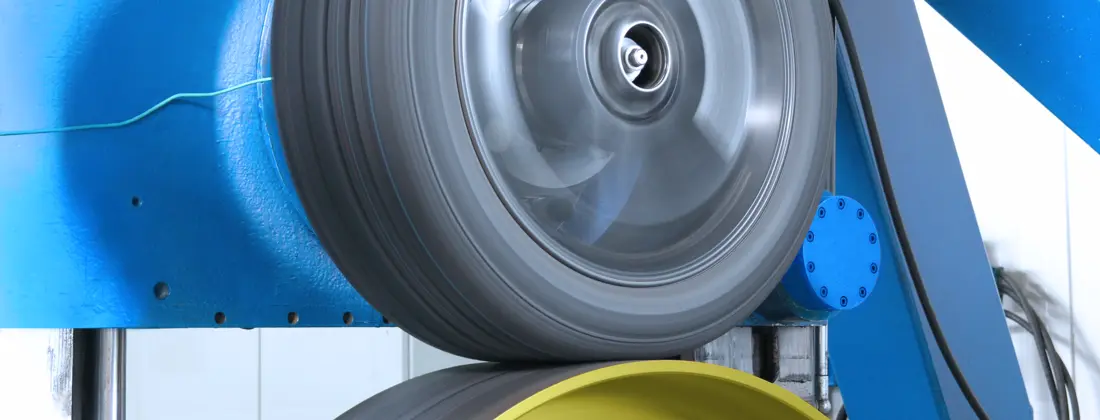SAE J1269 Steady State Tyre Rolling Resistance Test
The SAE J1269 Steady State Tyre Rolling Resistance Test is a standardized procedure for measuring the rolling resistance of tyres, which is critical in assessing fuel efficiency and vehicle performance. This test method is widely recognized within the automotive sector as a means to evaluate tyre design improvements aimed at reducing energy consumption during driving.
The SAE J1269 specifies conditions under which steady state rolling resistance can be measured with precision, ensuring consistent results across different laboratories. The test involves placing a tyre on a rotating drum where it is subjected to a constant speed and load, simulating real-world driving conditions as closely as possible. This allows for the accurate determination of how much energy is lost due to deformation within the tyre structure.
The rolling resistance coefficient (Crr) is calculated based on the force required to maintain a steady velocity over a given distance. A lower Crr indicates better fuel efficiency because less energy is wasted overcoming friction between the tyre and road surface. This metric plays a crucial role in automotive design, influencing both consumer choice and regulatory compliance.
One of the key aspects of this test is its ability to provide insights into various tyre properties beyond just rolling resistance. By analyzing how different materials or tread patterns affect the coefficient, manufacturers can optimize their products for specific market segments such as passenger cars, light trucks, or specialty vehicles like off-road rigs.
The process typically starts with careful preparation of the test specimen (tyre), ensuring that all parameters are controlled to minimize variability. Once prepared, the tyre is mounted on a specially designed drum that replicates road conditions while maintaining accuracy throughout the testing cycle.
Instrumentation plays an essential role in this procedure; high-precision sensors measure forces and displacements during rotation. Software tools then analyze these data points to calculate the rolling resistance coefficient accurately. Compliance with international standards like ISO 28303 further ensures reliability and consistency across diverse environments.
| Key Components of SAE J1269 |
|---|
| Rotating Drum |
| Constant Speed & Load Simulation |
| Force Measurement Sensors |
| Data Acquisition Software |
| Standardized Reporting Protocols |
This comprehensive approach ensures that the results obtained are not only reliable but also comparable internationally. As demand for more efficient vehicles continues to grow, accurate measures like those provided by SAE J1269 become increasingly important.
Understanding how this test impacts various stakeholders is crucial. For quality managers and compliance officers, knowing what constitutes acceptable levels of rolling resistance helps ensure adherence to industry regulations. R&D engineers rely heavily on these tests when developing new tyre technologies designed specifically for improved fuel economy or enhanced safety features. Procurement teams benefit from clear guidelines that help select suppliers capable of delivering high-performance tyres consistently.
Industry Applications
- Vehicle Manufacturers: Use SAE J1269 results to compare different tyre options during the design phase.
- R&D Engineers: Employ this test method to identify areas for improvement in tyre performance.
- Regulatory Bodies: Leverage these measurements as part of certification processes ensuring compliance with environmental standards.
The application of SAE J1269 extends beyond just automotive applications. Its principles are applicable to any industry where rolling friction plays a significant role, such as construction equipment or even consumer electronics if they incorporate rotating components.
| Sample Data Points from SAE J1269 |
|---|
| Rolling Resistance Coefficient (Crr) |
| Temperature Sensitivity of Crr |
| Treadwear Rating Influence on Crr |
By providing detailed insights into these factors, SAE J1269 supports informed decision-making across multiple sectors.
Customer Impact and Satisfaction
The impact of accurate tyre rolling resistance testing extends directly to consumers through better fuel efficiency and overall vehicle performance. When tyres have lower rolling resistance coefficients, vehicles consume less fuel over time, translating into savings at the pump for individual users.
For fleet operators, such improvements translate into substantial cost reductions. Less fuel means fewer emissions, contributing positively towards sustainability goals. Moreover, safer and more efficient driving experiences enhance customer satisfaction significantly.
The reliability of SAE J1269 also fosters trust among consumers who can be assured that their vehicles meet stringent quality standards. This aligns closely with broader environmental initiatives promoting greener transportation solutions globally.
International Acceptance and Recognition
SAE J1269 enjoys widespread acceptance worldwide, recognized by major automotive manufacturers, research institutions, and regulatory bodies alike. Its global adoption underscores its importance in the tyre testing field.
The United States Department of Energy (DOE) has endorsed SAE J1269 as part of their efforts to promote energy-efficient vehicles. Similarly, European Union directives reference this standard when setting new emission targets for passenger cars and light commercial vehicles.
International organizations like the International Organization for Standardization (ISO) have also incorporated aspects of SAE J1269 into broader automotive standards, further emphasizing its relevance in a global context.





